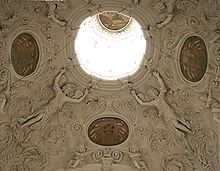Pilgrimage Chapel Maria Alber (Friedberg)
The Catholic pilgrimage chapel Maria Alber is a baroque central building in the west of the city of Friedberg ( Aichach-Friedberg district , Swabia ). The small church was built next to the connecting road to Augsburg and contains a replica of the Altötting image.
history
The pilgrimage goes back to the year 1686, when the Bavarian customs officer Arnold Schwenkh put a replica of the Altötting miraculous image into a hollow tree trunk. Schwenkh was part of the crew of the Hochzoll customs station (now part of Augsburg) at the nearby Lech crossing.
The increasing veneration of the "Altötting Mother of God" soon made it necessary to build a small wooden chapel. One year before his death, Schwenkh laid the foundation stone for the existing chapel, the shell of which was already completed in 1694. The formerly open vestibule and the stair tower were added in 1717. In 1938 the first major renovation was carried out under the Friedberg parish priest J. Wassermann. In 1939 the arcade arches of the vestibule were glazed. Another partial renovation began in 1968. In 1988 the chapel was finally completely renovated and is open again for prayer and inspection.
Because of its "border location" between Augsburg and Friedberg, the pilgrimage chapel belongs to the church of the Heilig-Geist Augsburg-Hochzoll and Friedberg-West parishes , but politically it belongs to the urban area of Friedberg.
description
The main building is a four-cone complex with a lantern dome. Four semicircular apses are attached to the actually square central room, so that the image of a round building results. Outside and inside, pilasters structure the complex. The curved gable in the west is unusual. The two bells hang open in round arches between the pilasters, an arrangement usually found in southern Europe. The octagonal lantern above the copper-clad dome is crowned by a curved hood like the stair tower.
The originally open vestibule in the west is kept rather simple. Two arched arcades between pilasters support the tiled roof. On the ceiling fresco , the donor kneels in front of the miraculous image in the tree trunk (Johann Reismiller, 1719).
The dome of the central building bears heavy acanthus stucco, Wessobrunner style . Four large stucco angels with outstretched arms seem to support the lantern ring, and in between small cartouches show Marian symbols.
The altar in the main room was built around 1700. The altar leaf shows the Holy Trinity (Johann Georg Knappich, 1719). The angel figures on the gables are attributed to Bartholomäus Eberl (1711). The four angels next to the tabernacle with the miraculous image probably created the Friedberg sculptor and goldsmith August Niggl in 1767. The tabernacle itself is by the Augsburg sculptor Bernhard Bendl.
literature
- Georg Dehio : Handbook of the German art monuments . Bayern III: Swabia (edited by Bruno Bushart and Georg Paula ). Munich 1989
- St. Maria Alber 1686–1936–1988 (Festschrift), Augsburg 1988
- Hubert and Gabriele Raab: Pilgrimage routes in the Wittelsbacher Land - around known and forgotten pilgrimage sites . Wißner-Verlag, Augsburg 2010, ISBN 978-3-89639-795-9 .
Web links
Coordinates: 48 ° 21 ′ 21.3 " N , 10 ° 57 ′ 31.6" E



